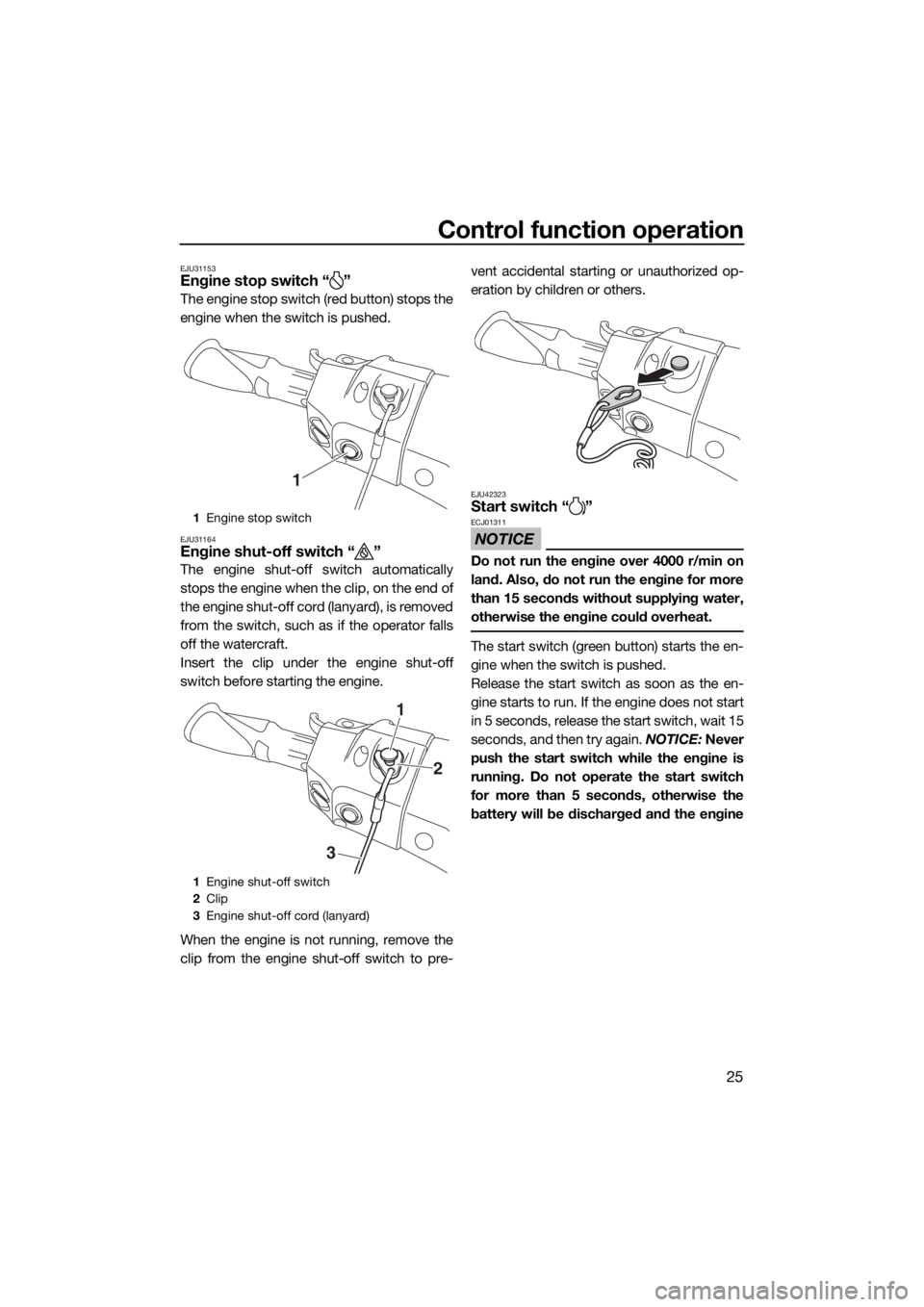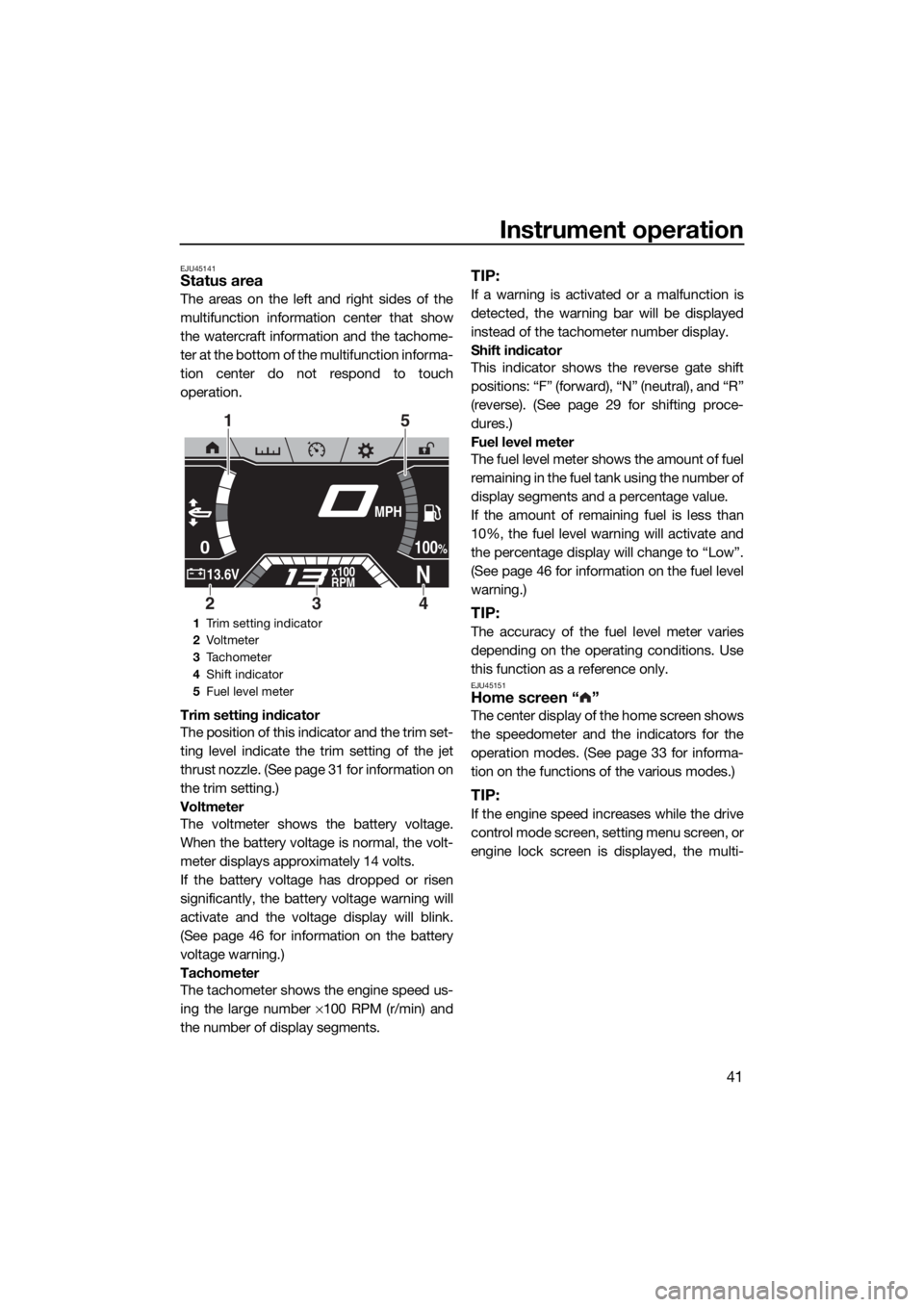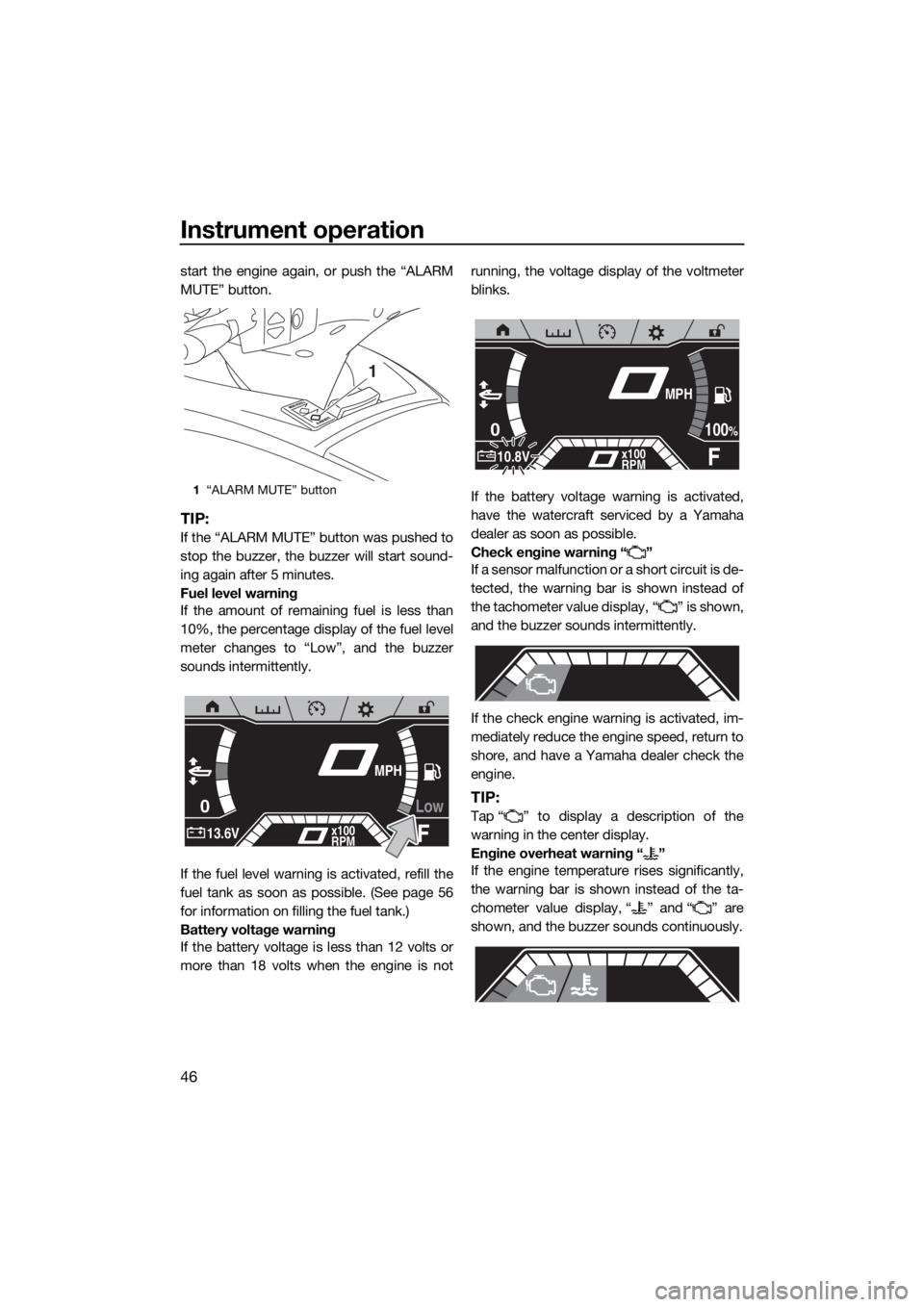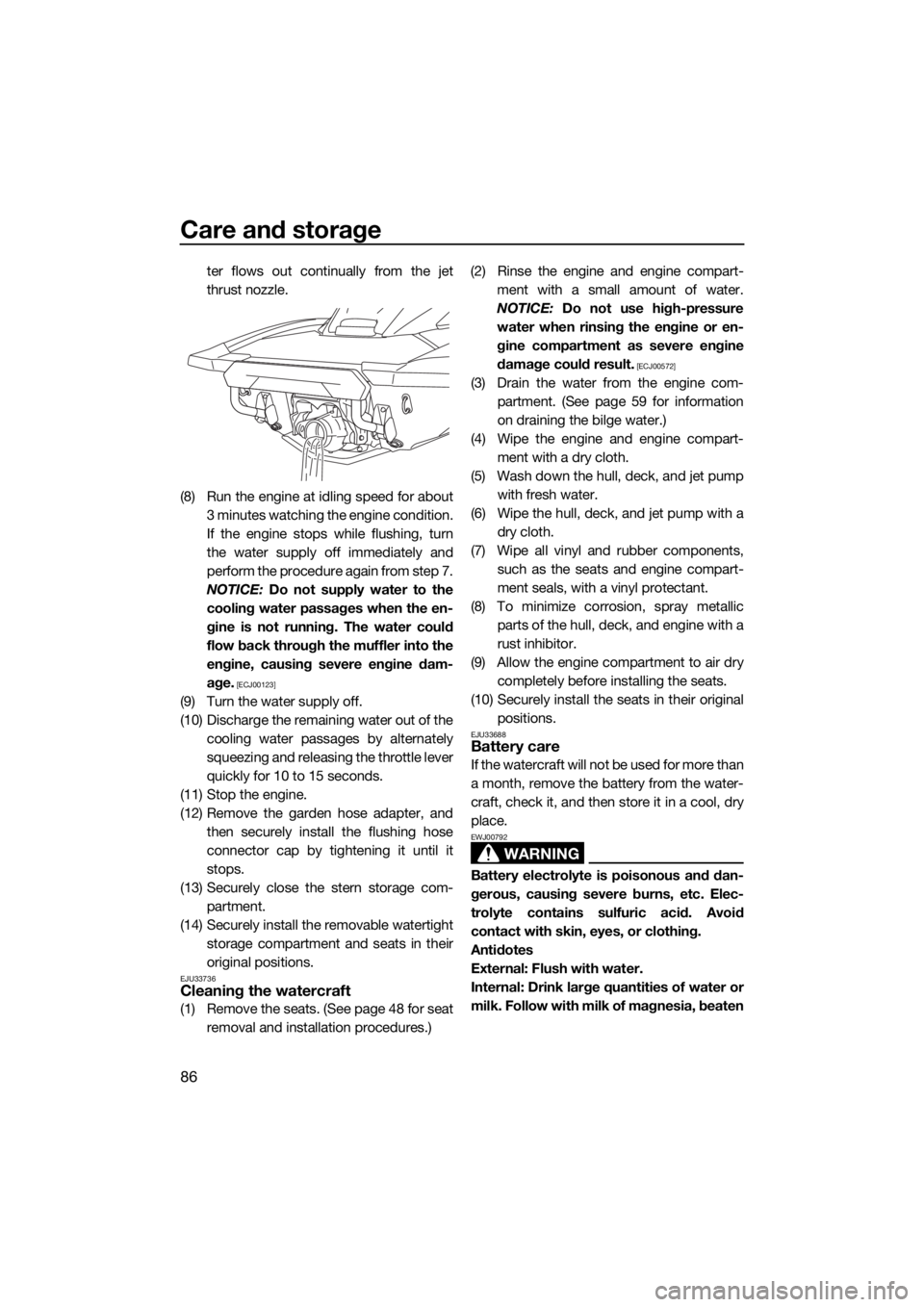battery YAMAHA FX HO CRUISER 2019 Owners Manual
[x] Cancel search | Manufacturer: YAMAHA, Model Year: 2019, Model line: FX HO CRUISER, Model: YAMAHA FX HO CRUISER 2019Pages: 116, PDF Size: 12.33 MB
Page 6 of 116

Table of contents
Draining the bilge water ................ 59
Draining the bilge water on land ...... 59
Draining the bilge water on water .... 60
Transporting on a trailer ................ 61
First-time operation ........................ 62
Engine break-in ............................. 62
Pre-operation checks ..................... 63
Pre-operation checklist .................... 63
Pre-operation check points........... 65
Pre-launch checks ........................... 65
Post-launch checks ......................... 71
Operation ......................................... 73
Operating your watercraft ............. 73
Getting to know your watercraft ...... 73
Learning to operate your
watercraft ...................................... 73
Riding position ................................. 74
Launching the watercraft ................. 74
Starting the engine on water ............ 74
Stopping the engine ......................... 75
Leaving the watercraft...................... 75
Operating the watercraft .................. 75
Turning the watercraft ...................... 76
Stopping the watercraft ................... 77
Operating the watercraft in reverse
or neutral ...................................... 78
Boarding the watercraft ................... 79
Starting off........................................ 81
Capsized watercraft ......................... 82
Beaching and docking the
watercraft ...................................... 83
Operating in weeded areas .............. 83
After removing the watercraft from
the water ....................................... 84
Care and storage............................. 85
Post-operation care ...................... 85
Flushing the cooling water
passages....................................... 85
Cleaning the watercraft .................... 86
Battery care ...................................... 86
Long-term storage ........................ 89
Cleaning ........................................... 89
Lubrication ....................................... 89
Rustproofing ..................................... 89
Maintenance .................................... 90
Maintenance ................................. 90
Tool kit.............................................. 90
Removing and installing the engine
cover ............................................. 90
Periodic maintenance chart ............. 92
Engine oil and oil filter ...................... 94
Specifications .................................. 95
Specifications ............................... 95
Trouble recovery ............................. 96
Troubleshooting ............................ 96
Troubleshooting chart ...................... 96
Emergency procedures ................ 99
Cleaning the jet intake and
impeller ......................................... 99
Raising the reverse gate ................ 100
Jumping the battery ....................... 100
Replacing the fuses ........................ 101
Towing the watercraft..................... 103
Submerged watercraft ................... 103
Index............................................... 105
UF3V70E0.book Page 2 Tuesday, August 28, 2018 10:16 AM
Page 29 of 116

Description
23
Engine compartment
12
5
7
8
910
6
43
1Dipstick (page 58)
2Engine oil filler cap (page 58)
3Electrical box
4Battery (page 66)
5Removable watertight storage compart-
ment (page 53)
6Spark plug/Ignition coil
7Fuel tank
8Water separator (page 28)
9Air filter case
10Engine cover
UF3V70E0.book Page 23 Tuesday, August 28, 2018 10:16 AM
Page 31 of 116

Control function operation
25
EJU31153Engine stop switch “ ”
The engine stop switch (red button) stops the
engine when the switch is pushed.
EJU31164Engine shut-off switch “ ”
The engine shut-off switch automatically
stops the engine when the clip, on the end of
the engine shut-off cord (lanyard), is removed
from the switch, such as if the operator falls
off the watercraft.
Insert the clip under the engine shut-off
switch before starting the engine.
When the engine is not running, remove the
clip from the engine shut-off switch to pre-vent accidental starting or unauthorized op-
eration by children or others.
EJU42323Start switch “ ”
NOTICE
ECJ01311
Do not run the engine over 4000 r/min on
land. Also, do not run the engine for more
than 15 seconds without supplying water,
otherwise the engine could overheat.
The start switch (green button) starts the en-
gine when the switch is pushed.
Release the start switch as soon as the en-
gine starts to run. If the engine does not start
in 5 seconds, release the start switch, wait 15
seconds, and then try again. NOTICE: Never
push the start switch while the engine is
running. Do not operate the start switch
for more than 5 seconds, otherwise the
battery will be discharged and the engine
1Engine stop switch
1Engine shut-off switch
2Clip
3Engine shut-off cord (lanyard)
1
1
2
3
UF3V70E0.book Page 25 Tuesday, August 28, 2018 10:16 AM
Page 47 of 116

Instrument operation
41
EJU45141Status area
The areas on the left and right sides of the
multifunction information center that show
the watercraft information and the tachome-
ter at the bottom of the multifunction informa-
tion center do not respond to touch
operation.
Trim setting indicator
The position of this indicator and the trim set-
ting level indicate the trim setting of the jet
thrust nozzle. (See page 31 for information on
the trim setting.)
Voltmeter
The voltmeter shows the battery voltage.
When the battery voltage is normal, the volt-
meter displays approximately 14 volts.
If the battery voltage has dropped or risen
significantly, the battery voltage warning will
activate and the voltage display will blink.
(See page 46 for information on the battery
voltage warning.)
Tachometer
The tachometer shows the engine speed us-
ing the large number ×100 RPM (r/min) and
the number of display segments.
TIP:
If a warning is activated or a malfunction is
detected, the warning bar will be displayed
instead of the tachometer number display.
Shift indicator
This indicator shows the reverse gate shift
positions: “F” (forward), “N” (neutral), and “R”
(reverse). (See page 29 for shifting proce-
dures.)
Fuel level meter
The fuel level meter shows the amount of fuel
remaining in the fuel tank using the number of
display segments and a percentage value.
If the amount of remaining fuel is less than
10%, the fuel level warning will activate and
the percentage display will change to “Low”.
(See page 46 for information on the fuel level
warning.)
TIP:
The accuracy of the fuel level meter varies
depending on the operating conditions. Use
this function as a reference only.
EJU45151Home screen “ ”
The center display of the home screen shows
the speedometer and the indicators for the
operation modes. (See page 33 for informa-
tion on the functions of the various modes.)
TIP:
If the engine speed increases while the drive
control mode screen, setting menu screen, or
engine lock screen is displayed, the multi-
1Trim setting indicator
2Vo l t m et e r
3Tachometer
4Shift indicator
5Fuel level meter
0
N13.6Vx100
RPM
100%
MPH
15
423
UF3V70E0.book Page 41 Tuesday, August 28, 2018 10:16 AM
Page 51 of 116

Instrument operation
45
Displaying the time since the last mainte-
nance (“Wellness”)
The total number of hours that the engine has
been running since the last watercraft main-
tenance can be displayed.
To reset the number of hours of operation:
(1) Tap the “Reset” button.
(2) Tap the “Confirm Reset” button to reset
the number of hours of operation.
Resetting the settings, trip information,
and fuel information (“Reset”)
The settings, trip information, and fuel infor-
mation can be reset to their factory default
settings. The items that are reset and the de-
fault settings are as follows.
Display units: US Unit
Language: English
Display brightness: 100%
Color setting: Blue
Trip time: 0.0
Distance traveled: 0.0
Average fuel consumption per gallon or li-
ter: 0.0
Total fuel used: 0.0
To reset the settings, trip information, and
fuel information:
(1) Tap the “Reset” button.
(2) Tap the “YES” button in the confirmation
screen.
EJU45190Engine lock screen “ ”
The engine lock screen shows the setting
screen for the Yamaha Security System in the
center display. (See page 24 for Yamaha Se-
curity System setting procedures.)
EJU45201Warning function
The multifunction information center can indi-
cate the following warnings.
Fuel level warning
Battery voltage warning
Check engine warning
Engine overheat warning
Oil pressure warning
Other warnings (communication errors, ex-
ceeding the maintenance intervals, and so
on)
To stop the buzzer when a malfunction is ac-
tivated, correct the cause of the problem and
Reset
Time Since Last
Maintenance
30.0Hrs
Reset
Reset To
Factory?
UF3V70E0.book Page 45 Tuesday, August 28, 2018 10:16 AM
Page 52 of 116

Instrument operation
46
start the engine again, or push the “ALARM
MUTE” button.
TIP:
If the “ALARM MUTE” button was pushed to
stop the buzzer, the buzzer will start sound-
ing again after 5 minutes.
Fuel level warning
If the amount of remaining fuel is less than
10%, the percentage display of the fuel level
meter changes to “Low”, and the buzzer
sounds intermittently.
If the fuel level warning is activated, refill the
fuel tank as soon as possible. (See page 56
for information on filling the fuel tank.)
Battery voltage warning
If the battery voltage is less than 12 volts or
more than 18 volts when the engine is notrunning, the voltage display of the voltmeter
blinks.
If the battery voltage warning is activated,
have the watercraft serviced by a Yamaha
dealer as soon as possible.
Check engine warning “ ”
If a sensor malfunction or a short circuit is de-
tected, the warning bar is shown instead of
the tachometer value display, “ ” is shown,
and the buzzer sounds intermittently.
If the check engine warning is activated, im-
mediately reduce the engine speed, return to
shore, and have a Yamaha dealer check the
engine.
TIP:
Tap “ ” to display a description of the
warning in the center display.
Engine overheat warning “ ”
If the engine temperature rises significantly,
the warning bar is shown instead of the ta-
chometer value display, “ ” and “ ” are
shown, and the buzzer sounds continuously.
1“ALARM MUTE” button
1
Low0
F13.6Vx100
RPM
MPH
0
F10.8Vx100
RPM
100%
MPH
UF3V70E0.book Page 46 Tuesday, August 28, 2018 10:16 AM
Page 69 of 116

Pre-operation checks
63
EJU31982
WARNING
EWJ00412
Failure to inspect or maintain the watercraft properly increases the possibility of an ac-
cident or damage to the watercraft. Do not operate the watercraft if you find any prob-
lem. If a problem cannot be corrected by the procedures provided in this manual, have
the watercraft inspected by a Yamaha dealer.
EJU41235Pre-operation checklist
Before using this watercraft, be sure to perform the checks in the following checklist.
ITEM ROUTINE PAGE
PRE-LAUNCH CHECKS
Engine compartmentVentilate the engine compartment.
Check inside the engine compartment for damage.65
Fuel systemCheck the fuel system for leakage.
Check the fuel level in the fuel tank.65
Water separatorCheck the water separator for water. 66
Engine unitCheck the exterior of the engine unit for damage. 66
Engine oil levelCheck the engine oil level. 66
Bilge waterCheck the engine compartment for bilge water. 66
BatteryCheck the battery connections and electrolyte level. 66
Steering systemCheck the steering system for proper operation. 67
Adjustable tilt steering sys-
temCheck the adjustable tilt steering system for proper
operation and check that the handlebars are se-
curely locked in place.68
RiDE lever Check the RiDE lever for proper operation. 68
Throttle leverCheck the throttle lever for proper operation. 68
Yamaha Security SystemCheck the Yamaha Security System for proper op-
eration.69
Engine shut-off cord (lan-
yard)Check the engine shut-off cord (lanyard) for dam-
age.69
SwitchesCheck the start switch, engine stop switch, and en-
gine shut-off switch for proper operation.69
Electric trim systemCheck the electric trim system for proper operation. 69
Storage compartmentsCheck the storage compartments for damage and
water.70
Fire extinguisher holder,
cover, and bandCheck the fire extinguisher holder, cover, and band
for damage.70
Fire extinguisherCheck the condition of the fire extinguisher. 70
Safety equipmentCheck that safety equipment meeting the applica-
ble regulations is on board.70
Hull and deckCheck the hull and deck for damage. 70
Jet intakeCheck the jet intake for damage and clogging. 70
UF3V70E0.book Page 63 Tuesday, August 28, 2018 10:16 AM
Page 72 of 116

Pre-operation checks
66
EJU32424Water separator check
Make sure that no water has collected in the
water separator. If water has collected in the
water separator, drain it. (See page 28 for in-
formation on draining the water separator.)
EJU40182Engine unit check
Check the exterior of the engine unit for dam-
age or other problem.
EJU36886Engine oil level check
Make sure that the engine oil level is between
the minimum and maximum level marks onthe dipstick. (See page 58 for information on
checking the engine oil level.)
EJU32456Bilge water check
Make sure that no bilge water has collected in
the engine compartment. If bilge water has
collected in the engine compartment, drain it.
(See page 59 for information on draining the
bilge water.)
EJU32485Battery checks
Make sure that the battery terminals and
breather hose are not damaged and that the
battery leads and breather hose are connect-
ed properly. WARNING! Fire or explosion
could result if the breather hose is dam-
1Water separator
1
1Dipstick
1Maximum level mark
2Minimum level mark
1
1
2
UF3V70E0.book Page 66 Tuesday, August 28, 2018 10:16 AM
Page 73 of 116
![YAMAHA FX HO CRUISER 2019 Owners Manual Pre-operation checks
67
aged, obstructed, or not connected prop-
erly.
[EWJ00452]
Make sure that the electrolyte level is be-
tween the minimum and maximum level
marks. WARNING! Never operate the wa- YAMAHA FX HO CRUISER 2019 Owners Manual Pre-operation checks
67
aged, obstructed, or not connected prop-
erly.
[EWJ00452]
Make sure that the electrolyte level is be-
tween the minimum and maximum level
marks. WARNING! Never operate the wa-](/img/51/49807/w960_49807-72.png)
Pre-operation checks
67
aged, obstructed, or not connected prop-
erly.
[EWJ00452]
Make sure that the electrolyte level is be-
tween the minimum and maximum level
marks. WARNING! Never operate the wa-
tercraft if the battery does not have suffi-
cient power to start the engine or if it
shows any other signs of decreased pow-
er. Loss of battery power may leave you
stranded.
[EWJ01241]
Make sure that the battery is securely held in
place.
EJU32614Steering system checks
Turn the handlebars to the right and left sev-
eral times to make sure that operation is
smooth and unrestricted throughout thewhole range, and that the free play is not ex-
cessive.
Turn the handlebars as far as possible to the
right and left to make sure that the jet thrust
nozzle moves as the handlebars are turned,
and that there is no difference between the
1Negative (–) battery terminal: Black lead
2Positive (+) battery terminal: Red lead
3Breather hose
1Maximum level mark
2Minimum level mark
1
32
UF3V70E0.book Page 67 Tuesday, August 28, 2018 10:16 AM
Page 92 of 116

Care and storage
86
ter flows out continually from the jet
thrust nozzle.
(8) Run the engine at idling speed for about
3 minutes watching the engine condition.
If the engine stops while flushing, turn
the water supply off immediately and
perform the procedure again from step 7.
NOTICE: Do not supply water to the
cooling water passages when the en-
gine is not running. The water could
flow back through the muffler into the
engine, causing severe engine dam-
age.
[ECJ00123]
(9) Turn the water supply off.
(10) Discharge the remaining water out of the
cooling water passages by alternately
squeezing and releasing the throttle lever
quickly for 10 to 15 seconds.
(11) Stop the engine.
(12) Remove the garden hose adapter, and
then securely install the flushing hose
connector cap by tightening it until it
stops.
(13) Securely close the stern storage com-
partment.
(14) Securely install the removable watertight
storage compartment and seats in their
original positions.
EJU33736Cleaning the watercraft
(1) Remove the seats. (See page 48 for seat
removal and installation procedures.)(2) Rinse the engine and engine compart-
ment with a small amount of water.
NOTICE: Do not use high-pressure
water when rinsing the engine or en-
gine compartment as severe engine
damage could result.
[ECJ00572]
(3) Drain the water from the engine com-
partment. (See page 59 for information
on draining the bilge water.)
(4) Wipe the engine and engine compart-
ment with a dry cloth.
(5) Wash down the hull, deck, and jet pump
with fresh water.
(6) Wipe the hull, deck, and jet pump with a
dry cloth.
(7) Wipe all vinyl and rubber components,
such as the seats and engine compart-
ment seals, with a vinyl protectant.
(8) To minimize corrosion, spray metallic
parts of the hull, deck, and engine with a
rust inhibitor.
(9) Allow the engine compartment to air dry
completely before installing the seats.
(10) Securely install the seats in their original
positions.
EJU33688Battery care
If the watercraft will not be used for more than
a month, remove the battery from the water-
craft, check it, and then store it in a cool, dry
place.
WARNING
EWJ00792
Battery electrolyte is poisonous and dan-
gerous, causing severe burns, etc. Elec-
trolyte contains sulfuric acid. Avoid
contact with skin, eyes, or clothing.
Antidotes
External: Flush with water.
Internal: Drink large quantities of water or
milk. Follow with milk of magnesia, beaten
UF3V70E0.book Page 86 Tuesday, August 28, 2018 10:16 AM